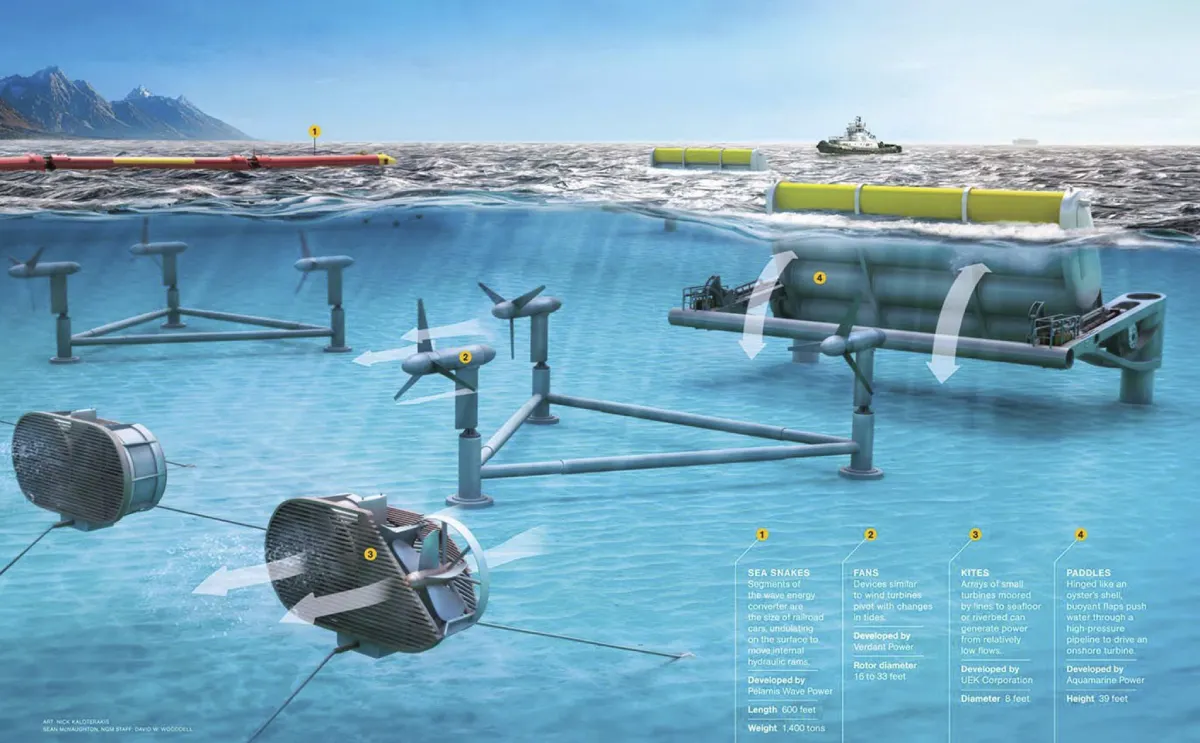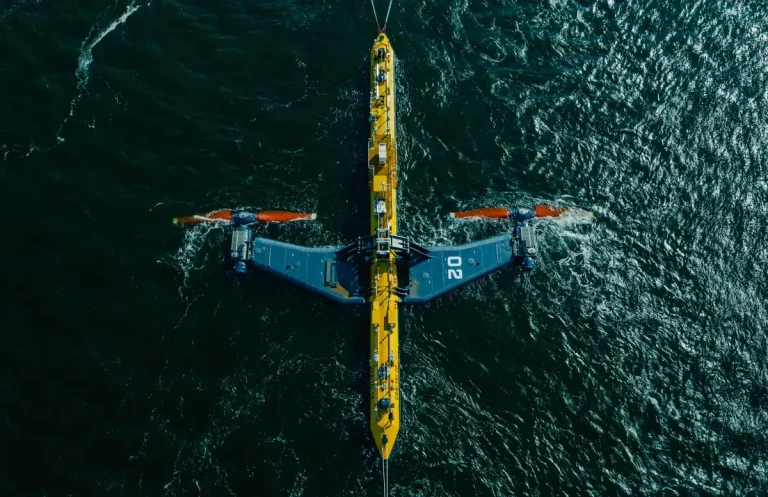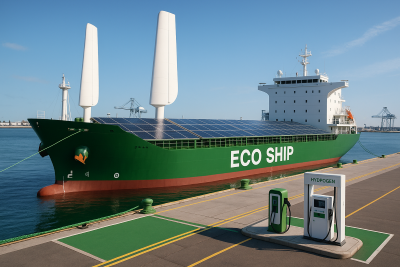A Comparative Guide: Tidal Energy vs. Wave Energy
As the worldwide emphasis transitions towards sustainable energy solutions, the potential of the oceans has emerged as a crucial field of investigation. Two prominent marine-oriented renewable energy sources tidal energy and wave energy frequently arise in discussions regarding clean energy. Although both capture energy from the ocean, they function based on different mechanisms and present distinct advantages and challenges.
In this guide, we will thoroughly explore tidal and wave energy, examining their operational principles, environmental effects, expenses, scalability, and future prospects. Whether you are a student, a policymaker, or an advocate for clean energy, this guide aims to enhance your understanding of how these two oceanic energies compare.
Table of Contents
- What Is Tidal Energy?
- What Is Wave Energy?
- Primary Differences Between Tidal and Wave Energy
- Benefits of Tidal Energy
- Benefits of Wave Energy
- Issues and Constraints
- Environmental Impact Assessment
- Financial Considerations and Infrastructure
- Global Initiatives and Case Studies
- Summary: Which Is Superior?
What Is Tidal Energy?
Tidal energy, or tidal power, is produced by the gravitational forces of the moon and sun, which lead to the fluctuation of ocean tides. This predictable water movement presents opportunities to harness energy through various technologies.
Key technologies utilized in tidal energy include:
- Tidal stream turbines: Underwater turbines placed in tidal currents that rotate with the tide’s flow
- Tidal barrages: Barriers constructed across estuaries that collect water during high tide and release it through turbines during low tide.
- Dynamic tidal power: A theoretical approach involving large dams positioned perpendicular to the coastline to take advantage of tidal phase variations.
Tidal energy is highly predictable, with patterns that can be forecast decades in advance.
-
What Is Wave Energy?
Wave energy, also referred to as wave power, is generated by the surface movement of the ocean triggered by winds blowing over the water. It is more variable than tidal energy but can be captured using floating or submerged devices.
Common devices for harnessing wave energy include:
- Point absorbers: Buoys that rise and fall with the waves, converting movement into electricity.
- Oscillating water columns: Hollow structures where wave movements causes to run turbine using air flow.
- Attenuators: Long, articulated floating structures that flex with wave motion, powering hydraulic pumps.
In contrast to tidal energy, wave energy is less predictable but more abundant. Unlike tidal energy, wave energy is less predictable but more widespread.
-
Key Differences Between Tidal and Wave Energy
| Feature | Tidal Energy | Wave Energy |
| Source of energy | Gravitational forces | Wind-generated waves |
| Predictability | High | Moderate |
| Technology maturity | Moderate | Emerging |
| Environmental impact | Estuarine ecosystems | Marine surface disruption |
| Geographic requirement | Narrow inlets, estuaries | Open coastlines |
| Energy consistency | Regular, cyclic | Variable, depends on weather |
-
Benefits of Tidal Energy
- Predictability: Tides are governed by celestial mechanics, making them highly forecastable.
- Energy density: Tidal flows are dense, capable of generating more power per unit area.
- Durability: Infrastructure such as tidal barrages can endure for decades.
- Low carbon emissions: Once established, tidal systems produce minimal to no greenhouse gas emissions.
-
Advantages of Wave Energy
- Enhanced availability: Oceans make up 70% of the Earth’s surface, providing immense wave energy potential.
- Minimal land disruption: Most devices are located offshore, minimizing environmental impact on land.
- Scalability: Modular technologies facilitate gradual implementation.
- High potential yield: In certain locations, wave energy could generate more electricity per square meter than solar or wind.
-
Challenges and Limitations
Tidal Energy:
Significant upfront expenses associated with infrastructure such as barrages.
- Ecological disturbances to estuarine ecosystems.
- Limited number of appropriate locations worldwide.
Wave Energy:
- Output is less predictable because it relies on weather conditions.
- Equipment may be damaged in challenging marine environments.
- Technology is still evolving and lacks uniform standards.
-
Comparison of Environmental Impact
Tidal energy, in particular with the use of barrages, can drastically change marine habitats by altering water flow, salinity levels, and sediment distribution. As a result ,this may affect fish migration patterns and the biodiversity of estuaries.
Wave energy, on the other hand, is generally less intrusive. However, it can still pose threats to marine life through underwater noise, collision hazards, and changes to habitats. Even so, its effects are typically regarded as less severe and more localized.
-
Cost and Infrastructure
Tidal Energy Expenses:
- High initial capital investments
- Long operational lifespan justifies the expenditure.
- Geographically constrained—only a limited number of sites provide suitable tidal variations.
Wave Energy Expenses:
- Lower startup costs but higher maintenance due to oceanic conditions.
- Developing technologies do not yet benefit from economies of scale.
- Potential for significant cost reductions as technologies advance.
According to the IEA, the cost of tidal energy is approximately $0.20–$0.30 per kWh, whereas wave energy costs between $0.30–$0.50 per kWh, depending on the specific project.
-
Global Initiatives and Case Studies
Tidal Energy Initiatives:
- La Rance Tidal Power Station, France: Active since 1966, this barrage generates 240 MW.
- MeyGen Project, Scotland: A tidal stream array with a target capacity of 398 MW.
Wave Energy Initiatives:
- Wave Roller, Portugal: An underwater device positioned near the coast that generates wave energy for the grid.
- Carnegie Clean Energy, Australia: Develops submerged buoys to capture wave energy off the coast of Perth.
These projects show both the promise and the challenges of marine energy.
-
Conclusion: Which Option Is Preferable?
All things considered, both tidal and wave energy present promising alternatives for sustainable, ocean-based electricity generation. While Tidal energy excels in predictability and long-term reliability, wave energy, by contrast offers broader possibilities provided that technological challenges are addressed.
In conclusion:
- Tidal energy is best suitable for regions with strong tidal variations and estuaries.
- Wave energy may become increasingly viable on a global scale as technology progresses.
Rather than favoring one over the other, a combined approach might be the most effective strategy for harnessing ocean energy for a sustainable future.
FAQs
Q1: Is wave energy more efficient than tidal energy?
Not necessarily. Tidal energy is typically more predictable and can be more efficient in suitable locations, therefore wave energy has greater global potential but fluctuates with weather conditions.
Q2: Are there environmental issues associated with tidal and wave energy?
Yes. Tidal energy can affect estuarine ecosystems, and wave energy may impact marine life. Both require thorough environmental evaluations.
Q3: Which nations are at the forefront of tidal and wave energy development?
The UK, France, and South Korea are leaders in tidal energy, while Australia and Portugal are making progress in wave energy initiatives.



